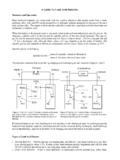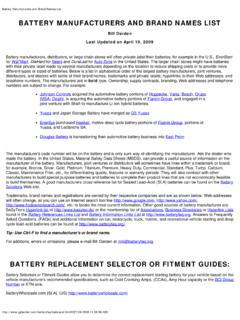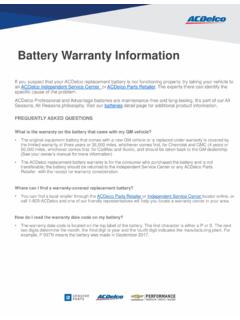Transcription of A Guide To Lead-Acid Batteries
1 A Guide To Lead-Acid BatteriesStructure and OperationMost Lead-Acid Batteries are constructed with the positive electrode (the anode) made from a lead-antimony alloy with lead (IV) oxide pressed into it, although Batteries designed for maximum life use alead-calcium alloy. The negative electrode (the cathode) is made from pure lead and both electrodes areimmersed in sulphuric acid. When the battery is discharged water is produced, diluting the acid and reducing its specific gravity. Oncharging sulphuric acid is produced and the specific gravity of the electrolyte increases. The specificgravity can be measured using a hydrometer and will have a value of about for a charged cell for a discharged cell, although these values will vary depending on the make of battery. Thespecific gravity also depends on the battery temperature and the above values or for a battery at 15 gravity is defined as: waterpure of volumesame theof masseelectrolyt of volumespecific a of mass Gravity Specific The chemical reactions that occur during charging and discharging are summarised in figures 1 and Lead-Acid Batteries are over discharged or left standing in the discharged state for prolonged periodshardened lead sulphate coats the electrodes and will not be removed during recharging.
2 Such build-upsreduce the efficiency and life of Batteries . Over charging can cause electrolyte to escape as of Lead-Acid Battery Starting Batteries Used to start and run engines they can deliver a very large current so a very shorttime, discharging by about 2-5%. If deep cycled these Batteries quickly degenerate and will fail after30-150 cycles but should last for a very long time when used correctly. Deep Cycle Batteries Used to store electricity in autonomous power systems ( solar, mini-Figure 1: Charging. Lead (IV) oxide is formed at the anode,pure lead is formed at the cathode and sulphuric acid isliberated into the electrolyte causing the specific gravity 2: Discharging. Lead sulphate is formed at bothelectrodes and sulphuric acid is removed from the electrolytecausing the specific gravity to ), for emergency back-up and electric vehicles. These Batteries are designed to discharge by asmuch as 80% of their capacity over thousands of charging and discharging cycles.
3 True deep cyclebatteries have solid lead plates however many Batteries that do not have solid plates are called semi-deep cycle. Marine Batteries Usually a hybrid battery that falls between deep cycle and starting batteriesalthough some are true deep cycle Batteries . hybrid Batteries should not be discharged by over 50%. Types of Deep Cycle Battery Flooded These Batteries have a conventional liquid electrolyte. Standard types have removablecaps so that the electrolyte can be diluted and the specific gravity measured, such Batteries aresupplied dry and you add distilled water. Standard flooded Batteries are cheap and if they are kepttopped up they are not overly sensitive to high charging voltages. Sealed Batteries are supplied pre-flooded and have fixed valves to allow gases to vent during use however, they will still leak ifinverted and the electrolyte can not be replenished so that over charging will cause damage.
4 Gelled Electrolyte The electrolyte is a jelly and so will not leak. The electrolyte can not be dilutedso that over charging must be avoided and these Batteries may only last for 2 or 3 years in hotclimates although with good care they can last for 5 years. absorbed glass Mat (AGM) Batteries The electrolyte is held between the plates absorbed in a fineboron-silicate mat. Like gelled electrolyte Batteries they will not leak acid but they can withstandmore careless treatment and are less sensitive to over charging since they are designed to retainvented gases. AGM Batteries can also stand for 30 days in a totally discharged state and still berecharged successfully. The major drawback to these Batteries is that they cost between 2 or 3 timesas much as flooded ResistanceBatteries transfer energy to electrons so that they 'flow' around a circuit, the Electro Motive Force(EMF) is the total amount of energy per coulomb of charge that a battery can supply and is measured involts.
5 The EMF of a Lead-Acid cell is provided by that chemical reactions described above (figures 1 and2) and can be seen as the maximum possible voltage across the cell's terminals (the open circuitvoltage). The path taken when current passes through the Lead-Acid cell will have resistance . Thisinternal resistance depends on the cell's design, construction, age and condition. On discharge thisinternal resistance (RC) causes the voltage measured across the cell's terminals to be less than the EMF(E) of the cell (the voltage drop = I x RC, figure 3a). Thus when a current (I) flows the terminal voltage(U) is given by:Figure 3: The internal resistance of a battery and the voltage measure across the terminals: (a) current flowingthrough a load; (b) no current U ExampleA cell has an internal resistance of and an EMF of what is its terminal potential differenceif it delivers (a) 1A, (b) 10A and (c) 50A?(a) ) (1 IR-E UC (b) 2V ) (10 IR-E UC (c) ) (50 IR-E UC Note that if a high resistance voltage meter is used to measure the voltage across a battery's terminals itwill register the Batteries EMF; as long as there is no current flowing through a load from the battery(figure 3b).
6 If the terminal voltage is measure when a current is flowing through a load from the battery,the meter will register the EMF minus the voltage drop across the internal resistance (figure 3a). When charging a cell the voltage applied across the terminals must be great enough to push the desiredcurrent against the cell's EMF. Therefore the effective voltage across the internal resistance is thedifference between the terminal voltage (in this case applied to the cell) and the the cells the current that flows is given by:CREUI and: CIR E U ExampleA cell with an EMF of 2V and an internal resistance of is to be charged at 5A. What terminalvoltage must be applied? ) (5 2 IR E U Cell and Battery VoltageA well maintained cell should have a cell EMF of about falling to about 2V when fullydischarged. Once the internal resistance has been taken into account the terminal voltage (the potentialdifference across the cell terminals) of each cell will be about , but this value will drop dependingon how much current is being drawn.
7 Six cells in series make up a twelve volt battery which when fullycharged will have a terminal voltage of to The EMF of Lead-Acid cells is dependent onchemistry although the actual terminal voltage differs depending on the battery design, this must betaken into account when using a voltmeter to determining the Batteries state of charge. Battery CapacityThe capacity of a battery is usually expressed as a number of ampere-hours (Ah). One ampere-hour isthe amount charge delivered when a current of one ampere is delivered for one hour. Since the capacityof Lead-Acid Batteries depend on the rate at which they are discharged a discharge rate is also example a battery with a 300Ah capacity when discharged over 10 hours (10 hour rate) can give(300 10) 30A continuously however, it may only have a 250Ah capacity when discharged at the 5 hourrate which will occur if (250 5) 50A are continually draw from it (figure 4).
8 In short the more slowlyyou discharge a battery the greater its capacity, deep-cycle battery capacities are normally quoted for the20 hour rate. Figure 4 shows a typical battery capacity versus discharge rate are sometimes expressed in terms of kilowatt-hours (kWh) which can be calculated from theampere-hour rate using the following equation:1000 volatgebatteryAhkWh Therefore a 12V battery with a capacity of 300Ah at the 10 hour rate will have a capacity of(12x300/1000) Ampere-hour is a measure of the amount of charge that a battery can deliver: one ampere is a flowof charge at the rate of one coulomb per second, therefore a number of amperes multiplied by a time( hours) gives us a quantity of charge. Similarly, the watt-hour is a measure of the amount of energythat a battery can deliver: one watt is the supply of energy at the rate of one joule per second, therefore anumber of watts multiplied by a time gives us a quantity of capacities of Lead-Acid Batteries are very dependent on the temperature at which the battery isoperating.
9 The Capacity is normally quoted for a temperature of 25 C however, the capacity will reduceby about 50% at -25 C and will increase to about 10% at 45 C (figure 5). Battery LifeIn a small autonomous power system ( one without a mains grid connection) the Batteries will becontinually charged and discharged. The life span of a deep-cycle battery is normally quoted in thenumber of cycles that it can be expected to perform, a cycle being a discharge followed by cycle Batteries should not be discharged by more than 60% of their capacity and the less youregularly discharge a battery the longer it will last. A battery in daily use and discharged by no moreFigure 4: The battery capacity vrs. discharge rate graphfor a Surrette Series 500 battery. The continuous current atvarious rates are also 5: Battery capacity vrs. operating temperature 40% of its capacity should last for more than 3000 cycles and may not need replacing for up to 12years.
10 A battery that is frequently heavily discharged may last no longer than 2 6 shows the variation in battery life with the depth to which it is StateThere are two main methods for determining the state of charge for Lead-Acid Batteries : Terminal Voltage - The open circuit voltage (no current flowing) of a fully charged cell depends onits type but will be to ( to for a 12V battery). If the voltage is measured withthe charging current flowing it will be increased by the voltage drop across the internal resistance. Ifdischarging the measured voltage will drop due to the internal resistance of the cell. Table 1 givesthe approximate battery and cell voltages for various states of charge. Specific Gravity This is the recommended method if the battery is not sealed and a hydrometer canget into the battery. For a flood-type battery in good condition the specific gravity should vary in theregion of for a fully charged battery to for a fully discharged battery.




